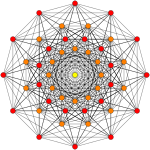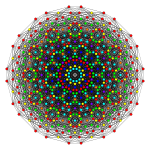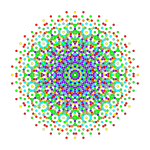 421 |
 142 |
 241 |
 Rectified 421 |
 Rectified 142 |
 Rectified 241 |
 Birectified 421 |
 Trirectified 421 | |
| Orthogonal projections in E6 Coxeter plane | ||
|---|---|---|
In 8-dimensional geometry, the 241 is a uniform 8-polytope, constructed within the symmetry of the E8 group.
Its Coxeter symbolis241, describing its bifurcating Coxeter-Dynkin diagram, with a single ring on the end of the 2-node sequences.
The rectified 241 is constructed by points at the mid-edges of the 241. The birectified 241 is constructed by points at the triangle face centers of the 241, and is the same as the rectified 142.
These polytopes are part of a family of 255 (28 − 1) convex uniform polytopes in 8-dimensions, made of uniform polytope facets, defined by all permutations of rings in this Coxeter-Dynkin diagram: ![]()
![]()
![]()
![]()
![]()
![]()
![]()
![]()
![]()
![]()
![]()
![]()
![]() .
.
| 241 polytope | |
|---|---|
| Type | Uniform 8-polytope |
| Family | 2k1 polytope |
| Schläfli symbol | {3,3,34,1} |
| Coxeter symbol | 241 |
| Coxeter diagram | |
| 7-faces | 17520: 240 231 17280 {36} |
| 6-faces | 144960: 6720 221 138240 {35} |
| 5-faces | 544320: 60480 211 483840 {34} |
| 4-faces | 1209600: 241920 {201 967680 {33} |
| Cells | 1209600 {32} |
| Faces | 483840 {3} |
| Edges | 69120 |
| Vertices | 2160 |
| Vertex figure | 141 |
| Petrie polygon | 30-gon |
| Coxeter group | E8, [34,2,1] |
| Properties | convex |
The 241 is composed of 17,520 facets (240 231 polytopes and 17,280 7-simplices), 144,960 6-faces (6,720 221 polytopes and 138,240 6-simplices), 544,320 5-faces (60,480 211 and 483,840 5-simplices), 1,209,600 4-faces (4-simplices), 1,209,600 cells (tetrahedra), 483,840 faces (triangles), 69,120 edges, and 2160 vertices. Its vertex figure is a 7-demicube.
This polytope is a facet in the uniform tessellation, 251 with Coxeter-Dynkin diagram:
The 2160 vertices can be defined as follows:
It is created by a Wythoff construction upon a set of 8 hyperplane mirrors in 8-dimensional space.
The facet information can be extracted from its Coxeter-Dynkin diagram: .
Removing the node on the short branch leaves the 7-simplex: . There are 17280 of these facets
Removing the node on the end of the 4-length branch leaves the 231, . There are 240 of these facets. They are centered at the positions of the 240 vertices in the 421 polytope.
The vertex figure is determined by removing the ringed node and ringing the neighboring node. This makes the 7-demicube, 141, .
Seen in a configuration matrix, the element counts can be derived by mirror removal and ratios of Coxeter group orders.[3]
| Configuration matrix | |||||||||||||||||
|---|---|---|---|---|---|---|---|---|---|---|---|---|---|---|---|---|---|
| E8 | k-face | fk | f0 | f1 | f2 | f3 | f4 | f5 | f6 | f7 | k-figure | notes | |||||
| D7 | ( ) | f0 | 2160 | 64 | 672 | 2240 | 560 | 2240 | 280 | 1344 | 84 | 448 | 14 | 64 | h{4,3,3,3,3,3} | E8/D7 = 192*10!/64/7! = 2160 | |
| A6A1 | { } | f1 | 2 | 69120 | 21 | 105 | 35 | 140 | 35 | 105 | 21 | 42 | 7 | 7 | r{3,3,3,3,3} | E8/A6A1 = 192*10!/7!/2 = 69120 | |
| A4A2A1 | {3} | f2 | 3 | 3 | 483840 | 10 | 5 | 20 | 10 | 20 | 10 | 10 | 5 | 2 | {}x{3,3,3} | E8/A4A2A1 = 192*10!/5!/3!/2 = 483840 | |
| A3A3 | {3,3} | f3 | 4 | 6 | 4 | 1209600 | 1 | 4 | 4 | 6 | 6 | 4 | 4 | 1 | {3,3}V( ) | E8/A3A3 = 192*10!/4!/4! = 1209600 | |
| A4A3 | {3,3,3} | f4 | 5 | 10 | 10 | 5 | 241920 | * | 4 | 0 | 6 | 0 | 4 | 0 | {3,3} | E8/A4A3 = 192*10!/5!/4! = 241920 | |
| A4A2 | 5 | 10 | 10 | 5 | * | 967680 | 1 | 3 | 3 | 3 | 3 | 1 | {3}V( ) | E8/A4A2 = 192*10!/5!/3! = 967680 | |||
| D5A2 | {3,3,31,1} | f5 | 10 | 40 | 80 | 80 | 16 | 16 | 60480 | * | 3 | 0 | 3 | 0 | {3} | E8/D5A2 = 192*10!/16/5!/2 = 40480 | |
| A5A1 | {3,3,3,3} | 6 | 15 | 20 | 15 | 0 | 6 | * | 483840 | 1 | 2 | 2 | 1 | { }V( ) | E8/A5A1 = 192*10!/6!/2 = 483840 | ||
| E6A1 | {3,3,32,1} | f6 | 27 | 216 | 720 | 1080 | 216 | 432 | 27 | 72 | 6720 | * | 2 | 0 | { } | E8/E6A1 = 192*10!/72/6! = 6720 | |
| A6 | {3,3,3,3,3} | 7 | 21 | 35 | 35 | 0 | 21 | 0 | 7 | * | 138240 | 1 | 1 | E8/A6 = 192*10!/7! = 138240 | |||
| E7 | {3,3,33,1} | f7 | 126 | 2016 | 10080 | 20160 | 4032 | 12096 | 756 | 4032 | 56 | 576 | 240 | * | ( ) | E8/E7 = 192*10!/72!/8! = 240 | |
| A7 | {3,3,3,3,3,3} | 8 | 28 | 56 | 70 | 0 | 56 | 0 | 28 | 0 | 8 | * | 17280 | E8/A7 = 192*10!/8! = 17280 | |||
| E8 [30] |
[20] | [24] |
|---|---|---|
| (1) |
||
| E7 [18] |
E6 [12] |
[6] |
| (1,8,24,32) |
Petrie polygon projections are 12, 18, or 30-sided based on the E6, E7, and E8 symmetries (respectively). The 2160 vertices are all displayed, but lower symmetry forms have projected positions overlapping, shown as different colored vertices. For comparison, a B6 coxeter group is also shown.
| D3 / B2 / A3 [4] |
D4 / B3 / A2 [6] |
D5 / B4 [8] |
|---|---|---|
| D6 / B5 / A4 [10] |
D7 / B6 [12] |
D8 / B7 / A6 [14] |
| (1,3,9,12,18,21,36) |
||
| B8 [16/2] |
A5 [6] |
A7 [8] |
| 2k1 figuresinn dimensions | |||||||||||
|---|---|---|---|---|---|---|---|---|---|---|---|
| Space | Finite | Euclidean | Hyperbolic | ||||||||
| n | 3 | 4 | 5 | 6 | 7 | 8 | 9 | 10 | |||
| Coxeter group |
E3=A2A1 | E4=A4 | E5=D5 | E6 | E7 | E8 | E9 = = E8+ | E10 = = E8++ | |||
| Coxeter diagram |
|||||||||||
| Symmetry | [3−1,2,1] | [30,2,1] | [[31,2,1]] | [32,2,1] | [33,2,1] | [34,2,1] | [35,2,1] | [36,2,1] | |||
| Order | 12 | 120 | 384 | 51,840 | 2,903,040 | 696,729,600 | ∞ | ||||
| Graph | - | - | |||||||||
| Name | 2−1,1 | 201 | 211 | 221 | 231 | 241 | 251 | 261 | |||
| Rectified 241 polytope | |
|---|---|
| Type | Uniform 8-polytope |
| Schläfli symbol | t1{3,3,34,1} |
| Coxeter symbol | t1(241) |
| Coxeter diagram | |
| 7-faces | 19680 total: |
| 6-faces | 313440 |
| 5-faces | 1693440 |
| 4-faces | 4717440 |
| Cells | 7257600 |
| Faces | 5322240 |
| Edges | 19680 |
| Vertices | 69120 |
| Vertex figure | rectified 6-simplex prism |
| Petrie polygon | 30-gon |
| Coxeter group | E8, [34,2,1] |
| Properties | convex |
The rectified 241 is a rectification of the 241 polytope, with vertices positioned at the mid-edges of the 241.
It is created by a Wythoff construction upon a set of 8 hyperplane mirrors in 8-dimensional space, defined by root vectors of the E8 Coxeter group.
The facet information can be extracted from its Coxeter-Dynkin diagram: .
Removing the node on the short branch leaves the rectified 7-simplex: .
Removing the node on the end of the 4-length branch leaves the rectified 231, .
Removing the node on the end of the 2-length branch leaves the 7-demicube, 141 .
The vertex figure is determined by removing the ringed node and ringing the neighboring node. This makes the rectified 6-simplex prism, .
Petrie polygon projections are 12, 18, or 30-sided based on the E6, E7, and E8 symmetries (respectively). The 2160 vertices are all displayed, but lower symmetry forms have projected positions overlapping, shown as different colored vertices. For comparison, a B6 coxeter group is also shown.
| E8 [30] |
[20] | [24] |
|---|---|---|
| (1) |
||
| E7 [18] |
E6 [12] |
[6] |
| (1,8,24,32) |
| D3 / B2 / A3 [4] |
D4 / B3 / A2 [6] |
D5 / B4 [8] |
|---|---|---|
| D6 / B5 / A4 [10] |
D7 / B6 [12] |
D8 / B7 / A6 [14] |
| (1,3,9,12,18,21,36) |
||
| B8 [16/2] |
A5 [6] |
A7 [8] |
|
Fundamental convex regular and uniform polytopes in dimensions 2–10
| ||||||||||||
|---|---|---|---|---|---|---|---|---|---|---|---|---|
| Family | An | Bn | I2(p) / Dn | E6 / E7 / E8 / F4 / G2 | Hn | |||||||
| Regular polygon | Triangle | Square | p-gon | Hexagon | Pentagon | |||||||
| Uniform polyhedron | Tetrahedron | Octahedron • Cube | Demicube | Dodecahedron • Icosahedron | ||||||||
| Uniform polychoron | Pentachoron | 16-cell • Tesseract | Demitesseract | 24-cell | 120-cell • 600-cell | |||||||
| Uniform 5-polytope | 5-simplex | 5-orthoplex • 5-cube | 5-demicube | |||||||||
| Uniform 6-polytope | 6-simplex | 6-orthoplex • 6-cube | 6-demicube | 122 • 221 | ||||||||
| Uniform 7-polytope | 7-simplex | 7-orthoplex • 7-cube | 7-demicube | 132 • 231 • 321 | ||||||||
| Uniform 8-polytope | 8-simplex | 8-orthoplex • 8-cube | 8-demicube | 142 • 241 • 421 | ||||||||
| Uniform 9-polytope | 9-simplex | 9-orthoplex • 9-cube | 9-demicube | |||||||||
| Uniform 10-polytope | 10-simplex | 10-orthoplex • 10-cube | 10-demicube | |||||||||
| Uniform n-polytope | n-simplex | n-orthoplex • n-cube | n-demicube | 1k2 • 2k1 • k21 | n-pentagonal polytope | |||||||
| Topics: Polytope families • Regular polytope • List of regular polytopes and compounds | ||||||||||||